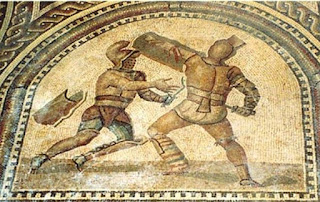amphitheātrum
The Romans loved going to the games (lūdī) which comprised hand-to-hand combat between the gladiators (gladiātōrēs), or hunters (vēnātōrēs) fighting wild animals in hunting shows (vēnātiōnēs ).
These events took place in large stadiums, the most famous of which is the Colosseum in Rome although, during the time of the Ancient Romans, the Colosseum was known as the Amphitheatrum Flavium, named after the dynasty of Emperors (Flavius) which oversaw its construction. Stadiums, albeit of a smaller scale, were built throughout the Empire.
oppidum
Generally translated as ‘town’, ‘oppidum’ refers to a main settlement in any administrative centre of Ancient Rome. The Romans used the term for settlements smaller than a city (urbs) although Roman cities themselves were by no means as large as modern-day equivalents. The oppidum was often fortified, and the style would vary depending on where in the Roman Empire it had been constructed. The image above is a reconstruction of an oppidum in Gaul.
tabula; stilus
Romans did not have books in the way we manufacture them. They would write on a papyrus scroll (volumen) or, for writing that was not designed to be preserved, on a tabula, a wax tablet. When writing on a tabula a thin piece of wood or metal called a stilus which was pointed at one end, was used to scratch the letters into the wax.
vicus
Vicus refers to either a district in a town, a neighbourhood, or a village, the smallest administrative unit of a Roman provincial town.
via
The Romans were masters of road construction, one of the most well-known routes being the Via Appia (the Appian Way) which connected Rome to the major port of Brundisium (modern-day Brindisi) in SE Italy. The image below shows the Roman pillar marking the end of the Appian Way in Brundisium.
vīlla
A ‘villa’ was a large and sprawling house, often with surrounding arable land, which was in the countryside or just outside the city. Many wealthy Romans owned a villa in addition to their accommodation in the city and was a place to escape from the noise and bustle of urban life.
vīnum
The wine in the glass bottle in the image below may not look all that tempting, but it is the oldest unopened bottle of wine in the world! It is dated from between 325 and 350 CE and was found in the tomb of a Roman nobleman. Wine was stored in a large vessel (amphora) with a pointed bottom to allow for transportation by ship. Had our nobleman lived long enough to enjoy his wine, he would have poured it into a drinking-cup (poculum).





No comments:
Post a Comment